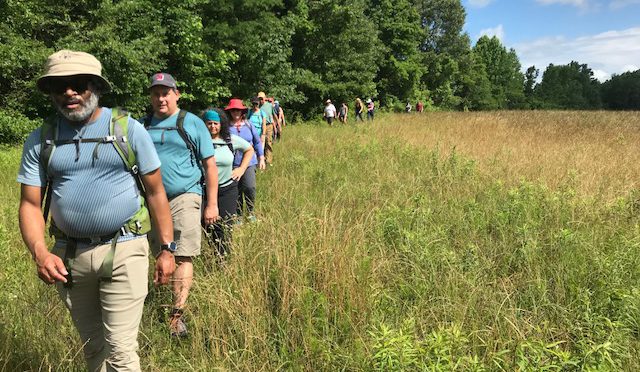We’ve encountered our first 90-degree days on the trail. We’ve also encountered our first signs of heat exhaustion (on a sweaty trip deep into Linville Gorge this past weekend).
Heat exhaustion can lead to heat stroke which can damage the brain and other organs and can lead to death. Fortunately, if you recognize and treat heat exhaustion at the outset you can keep it from devolving into something much more serious.
Recognize the symptoms
The key is recognizing the symptoms, which include:
- Confusion
- Dark-colored urine (a sign of dehydration)
- Dizziness
- Fainting
- Fatigue
- Headache
- Muscle or abdominal cramps
- Nausea, vomiting, or diarrhea
- Pale skin
- Profuse sweating
- Rapid heartbeat
React to the symptoms
If you recognize these symptoms in yourself or in a hiking partner, get them out of the heat as quickly as possible — into the shade, into water if it’s nearby. You also want to:
- Drink plenty of fluids, especially sports drinks to replace lost salt. Avoid caffeinated beverages and alcohol.
- Remove tight or unnecessary clothing.
- Douse a bandana in cool water and swab the victim with it.
Be aware that if can take longer to cool a victim of heat exhaustion if the relative humidity is 60 percent or more (which is typically is in these parts) and if the heat index is 90 or greater.
Especially vulnerable hikers
Folks especially subject to heat exhaustion include:
- Children under 4
- Adults over 65
- People with health conditions including heart lung and kidney disease, high blood pressure, diabetes, sickle cell trait and more.
- People on certain medications, including diuretics, sedatives, tranquilizers, stimulants, heart and blood pressure medications.
Cool places to hike
For summer hikes when it’s especially hot we recommend:
- Trails with good tree cover. The canopy can reduce the temperature by 10 degrees.
- Trails along water. Cooling off periodically — even just shedding the hiking shoes and wading in — can help keep your temperature down.
- Trails at elevation. A good rule of thumb is that the temperature drops about 3.3 degrees F for every 1,000 feet of elevation gain. So if it’s 90 degrees in Raleigh (elevation 315 feet), it will be about 70 atop Mount Mitchell (elevation 6,684 feet).
- Taking a bandana that you can soak periodically and wrap around your neck.
- Packing cold water. If you prefer drinking from bottles, the night before a hike, fill a water bottle half full and put it in the freezer; the next morning, top it off with cold tap water. It should remain cold for an hour on the trail, cool for another half hour. If you’re a bladder person, fill it with ice, then top off with water. Again, you should have cool water for a good hour and a half or so.
Above all, try to nip heat exhaustion in the bud before it becomes an issue by staying hydrated on the trail! This time of year we recommend an absolute minimum of 2 liters for hikes of 5 miles or less (and more under extreme heat or on an especially challenging trail). If you’re hiking in the mountains and going long, bring a water filter (or make sure someone in your group has one).
Folks who are especially worried about heat exhaustion should check out the article Heat Exhaustion on WebMD.com, from which most of the information in this article was cribbed.
Enjoy your summer hiking by staying hydrated and staying cool.
Happy Trails,
Joe
Cool off with us
GetHiking! Classic Weekend: Lake James State Park and Fonta Flora Trail, May 31-June 2. Hike the state’s emerging Fonta Flora State Trail, which will one day link Morganton on the east with Asheville to the west. Plus: swimming in the cool waters of Lake James. (Note: Registration for this trip ends Friday, May 24, at 5 p.m.) Learn more here.
GetBackpacking! Refresher at South Mountains State Park, June 7-9. An easy backpacking getaway that’s perfect for the rusty backpacker and the backpacker just getting into the sport. Learn more here.
Appalachian Trail: Carvers Gap north to US 19E. This weekend, June 28-30. This two-night backpacking trip proved so popular we’ve scheduled a second to handle the overflow. This weekend’s trip is sold out; find details on our June 28-30 trip, go here.
Wilson Creek, May 31-June 2.There’s a theme to this trip: Going Solo. We spend the first night as a group, exploring, among other things, the aforementioned Gragg Prong. On the second night, we deposit backpackers in roughly 150-yard intervals to spend the night on their own. Great opportunity for backpackers interested, but uncertain, about going solo. Learn more here.
Joyce Kilmer-Slickrock/Citico Creek Wilderness, July 18-21. We hike in about four and a half miles on this trip, establish base camp at Naked Ground, then spend two days day hiking before hiking out. Learn more here.
Standing Indian, Aug. 15-18. From our car camp basecamp we’ll have two and a half days of hiking: Friday, an 11-mile loop taking in the Appalachian Trail and topping out on Standing Indian; Saturday, a 7.5-mile hike topping out on Albert Mountain and also including the AT; Sunday, two short waterfall hikes before heading home. Learn more here.
